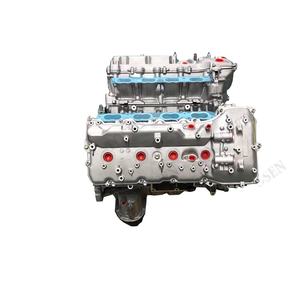Opel Corsa Engine: Common Issues and How to Take care of Them
Opel Corsa Engine: Common Issues and How to Take care of Them
Blog Article
Comprehensive Testimonial of a Subcompact Car's Powertrain Capabilities
In the realm of auto design, the powertrain of a subcompact vehicle stands as an important nexus where efficiency, effectiveness, and advancement converge. When inspecting the detailed web of parts that propel these cars ahead, one reveals a symphony of design wonders waiting to be dissected. From the engine's unrelenting quest of optimal performance to the transmission's seamless choreography of power distribution, every component plays a critical duty in specifying the overall driving experience. Past the surface lies a trove of understandings waiting to be unearthed, assuring a much deeper understanding of exactly how these powertrains genuinely make out in the realm of functional application.
Engine Efficiency Analysis
In evaluating the engine performance of the subcompact automobile, a thorough analysis exposes its efficiency and power output under different driving problems. The subcompact automobile's engine, an important component of its powertrain system, shows extensive performance metrics. The engine's performance is significant, as it enhances fuel usage without jeopardizing power shipment. Under normal driving conditions, the engine operates smoothly, showcasing a balance in between efficiency and fuel economic situation.
Furthermore, when subjected to strenuous testing circumstances such as high-speed velocity or uphill climbs, the engine demonstrates durability and responsiveness. Its power outcome stays regular, offering sufficient velocity when needed. The subcompact automobile's engine is customized to meet the needs of city driving, where quick velocity and active maneuverability are vital.
Moreover, the engine's style incorporates contemporary innovations that improve its efficiency qualities. Attributes like turbocharging or variable valve timing add to improved power delivery and torque, improving the overall driving experience. To conclude, the engine efficiency of the subcompact auto underscores its capability to deliver trusted and effective power outcome throughout various driving conditions.
Transmission Performance Assessment
Analyzing the subcompact cars and truck's transmission effectiveness entails evaluating its performance in transferring power seamlessly throughout different driving conditions. The effectiveness of a transmission system is critical as it directly impacts the total performance and gas economic climate of the vehicle. In evaluating transmission performance, variables such as equipment ratios, change timing, and the level of smoothness of equipment changes are considered. A well-designed transmission system should successfully supply power from the engine to the wheels while minimizing power losses.
One common method utilized to examine transmission effectiveness is through dynamometer testing, where the power outcome from the engine is gauged at the input and result shafts of the transmission. By evaluating these facets, engineers can recognize areas for improvement and optimize the transmission system for much better total performance and performance.
Gas Effectiveness Assessment
The assessment of the subcompact car's gas effectiveness includes a thorough analysis of its usage prices under various driving conditions. Gas effectiveness is a vital factor in examining the overall performance and cost-effectiveness of a lorry. By measuring the quantity of gas taken in each range took a trip, usually expressed as miles per gallon (MPG) or litres per 100 kilometers (L/100 km), the performance of the subcompact cars and truck's powertrain can be determined.

In addition, innovations in technology, such as crossbreed systems, regenerative braking, and automatic start-stop systems, have actually significantly enhanced fuel effectiveness in modern subcompact cars and trucks. Producers proceed to innovate and optimize powertrain elements to boost fuel performance while fulfilling efficiency demands and ecological regulations. Reviewing a subcompact auto's fuel performance gives beneficial understandings for consumers looking for sustainable and affordable transport options.
Velocity and Handling Evaluation
An essential element of evaluating the efficiency abilities of a subcompact automobile hinges on examining its acceleration and taking care of features. Acceleration is vital as it establishes how swiftly the car can get to wanted rates, affecting overall driving experience and maneuverability in various traffic problems. opel corsa engine. Subcompact cars and trucks are frequently preferred for their nimbleness and agility, making acceleration from grinding halt and throughout surpassing maneuvers crucial aspects to consider
When it pertains to handling, a subcompact auto's capacity to navigate corners, maintain security at broadband, and offer a responsive guiding feel are paramount. Tight city streets and winding roadways require specific handling to make certain chauffeur confidence and security. Aspects such as suspension adjusting, weight distribution, and tire grasp play substantial duties in figuring out a subcompact auto's overall handling prowess.

Powertrain Components Review
Upon delving into the complexities of a subcompact cars and truck's performance, a detailed exam of its powertrain elements is necessary my blog to realize the car's mechanical foundations. The powertrain of a subcompact automobile commonly is composed of the engine, transmission, driveshaft, differential, and axles. Recognizing just how these parts work together is important in examining a subcompact vehicle's overall efficiency, performance, and driving dynamics.
Final Thought
In verdict, the subcompact automobile's powertrain abilities have actually been thoroughly assessed in terms of engine efficiency, transmission efficiency, gas handling, velocity, and performance. The comprehensive review highlights the relevance of each element interacting effortlessly to provide ideal efficiency. Generally, the powertrain elements of the subcompact cars and truck have actually been discovered to be healthy and reliable, making it a reputable selection for chauffeurs looking for a small and fuel-efficient vehicle.
In the realm of auto engineering, the powertrain of a subcompact auto stands as an essential nexus where efficiency, effectiveness, and development converge.In analyzing the engine efficiency of the subcompact auto, a thorough evaluation discloses its effectiveness and power outcome under various driving conditions.Assessing the subcompact car's transmission efficiency involves evaluating its efficiency in transferring power perfectly throughout various driving conditions. Comprehending just how these parts function with each other is vital in evaluating a subcompact vehicle's general efficiency, effectiveness, and driving characteristics.In conclusion, the subcompact car's powertrain capabilities have actually been extensively evaluated in terms of engine find out this here performance, transmission performance, fuel handling, velocity, and performance.
Report this page